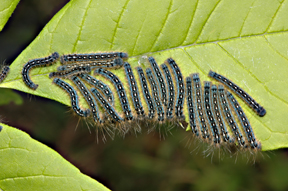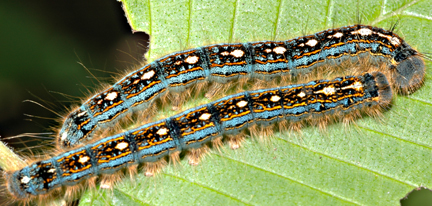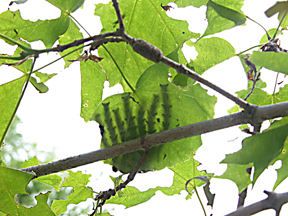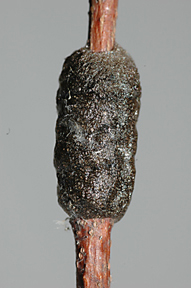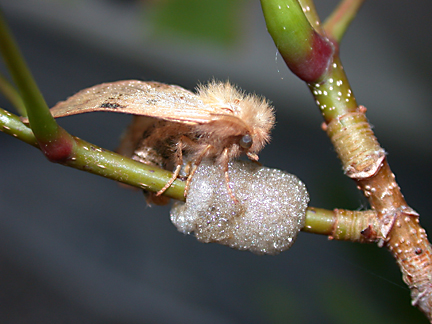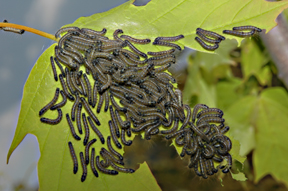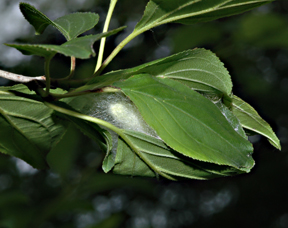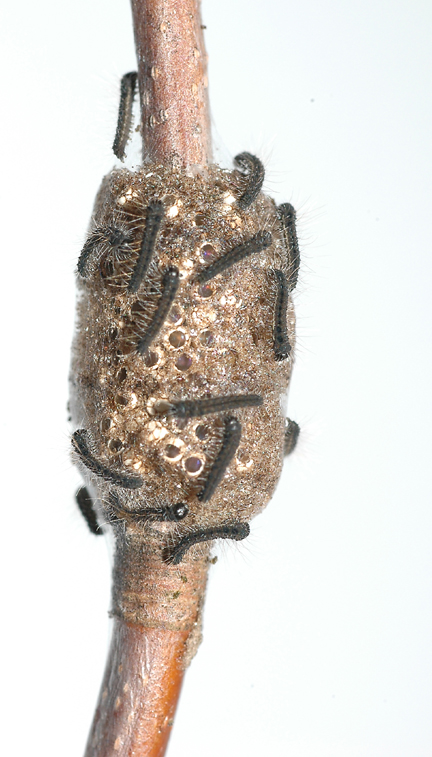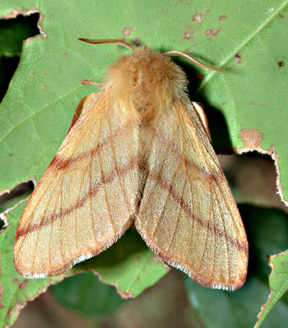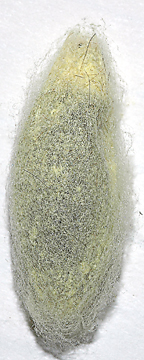Fitzgerald, T. D. and Costa, J. T. 1986. Trail-based communication and foraging behavior of young colonies of the forest tent caterpillar Malacosoma disstria Hubn. (Lepidoptera: Lasiocampidae). Ann. Entomol. Soc. Am. 79: 999-1007.
Fitzgerald, T. D. and F. X. Webster. 1993. Identification and behavioral assays of the trail pheromone of the forest tent caterpillar Malacosoma disstria Hubner (Lepidoptera: Lasiocampidae). Can. J. Zool. 71:1511-1515.
Fitzgerald, T. D. 1995. The Tent Caterpillars. Cornell University Press. 303p.
Life Stages of the Forest Tent Caterpillar
(A) Adult ovipositing. The spumaline that covers the egg mass is light colored when first deposited. (B) Egg mass several weeks after deposition, covered with the now darkened spumaline, (C) Egg mass with spumaline removed revealing individual eggs, (D) Newly eclosed first instar caterpillars.
(H) Cocoon impregnated with yellow crystals of calcium oxylate secreted from the Malpighian tubles of the last instar caterpillar, (I) Pupa removed from the cocoon.
(E) Second instar caterpillars basking, (F) Fifth instar caterpillars, (G) Cocoon spun in leaves of host tree
The forest tent caterpillar is broadly distributed throughout North America. As with all tent caterpillars, there is just one generation each year. The egg mass with its enclosed quiescent caterpillars is the overwintering stage. Eggs hatch and the first of the active larval instars appears in the early spring just as the buds of the host tree are begining to expand. The caterpillars grow rapidly and after feeding for about 2 months, spin cocoons and pupate. About 3 weeks later the adults appear and shortly thereafter the moths lay their eggs and die.
The forest tent caterpillar is polyphagous but prefers to lay its eggs on particular trees. In the Northeast, the favored ovipositional hosts are sugar maple and red oak. However, the caterpillars frequently leave their natal tree and consume the leaves of many other species of hardwood trees. One exception is the red maple, which is not attacked by the caterpillars and is one of the few trees to remain foliated during outbreaks.
This is the only tent caterpillar that does not build a tent. The caterpillars aggregate on pads of silk spun on leaf and bark surfaces The larvae are nomadic, frequently abandoning a resting site, or biovouac, in favor of another. Frequent movement is most often related to foraging and thermoregulation.
Caterpillars launch forays from their resting sites in search of food, laying down exploratory trails. The trail pheromone is deposited when the caterpillars drag the undersides of their last abdominal segments against the substrate. The first caterpillars to finish feeding typically move away from the feeding site and establish a new resting site. The newly fed caterpillars lay down recruitment trails which serve to guide the remainder of` the colony to the new bivouac. Forest tent caterpillars appear to use the same trail pheromone as the eastem tent caterpillar and they are occasionally found camping out on the tents of the latter (photo to left).
During the spring of 2006 at one site near Tully in central New York State the timing of the life cycle was as follows:
April 17 Eggs hatch
May 1 Leaf flush on sugar maple
June 16 Caterpillars begin to spin cocoons
July 3 First moths emerge and begin to oviposit
